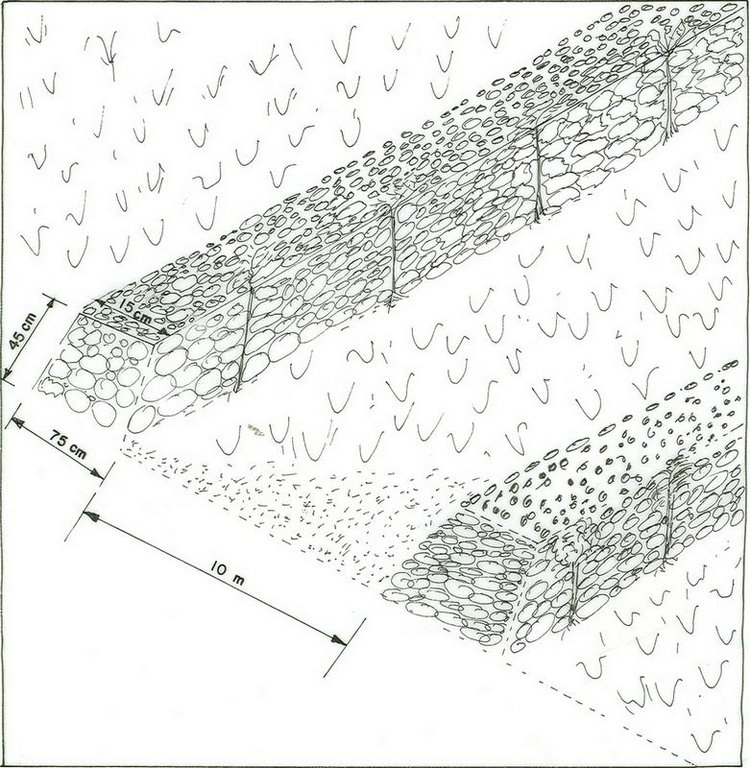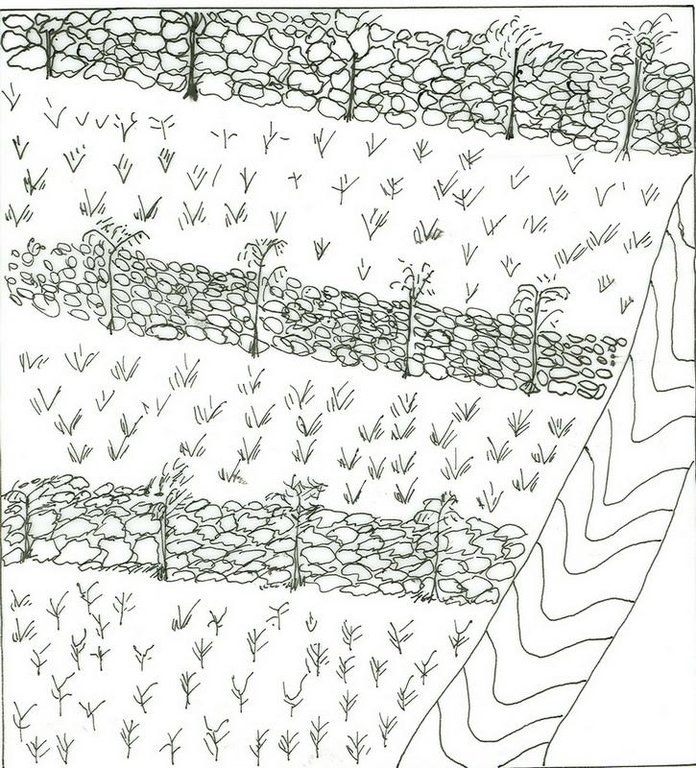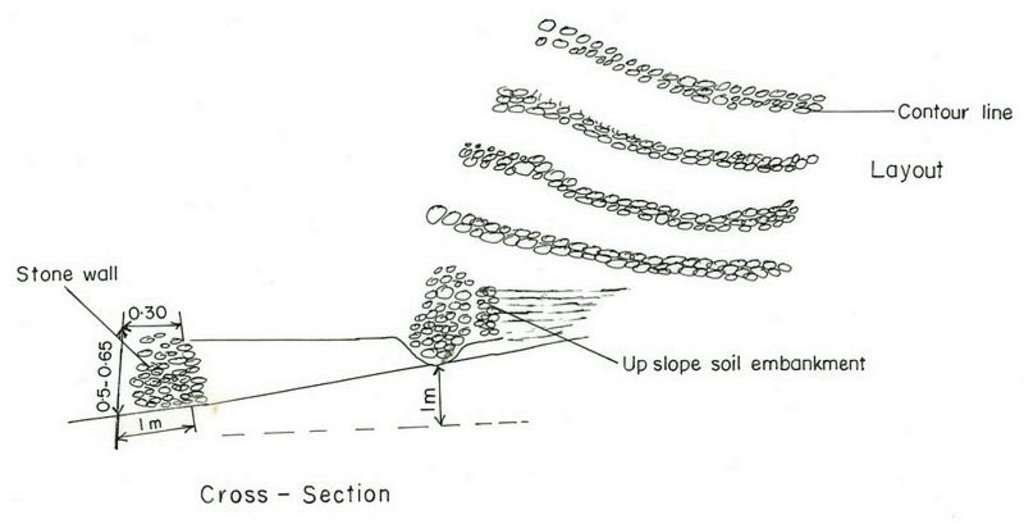Dejen Stone Bund [Ethiopie]
- Création :
- Mise à jour :
- Compilateur : Unknown User
- Rédacteur : –
- Examinateurs : Fabian Ottiger, Alexandra Gavilano
Gidad, Irken
technologies_1059 - Ethiopie
Voir les sections
Développer tout Réduire tout1. Informations générales
1.3 Conditions relatives à l'utilisation par WOCAT des données documentées
Le compilateur et la(les) personne(s) ressource(s) acceptent les conditions relatives à l'utilisation par WOCAT des données documentées:
Oui
2. Description de la Technologie de GDT
2.1 Courte description de la Technologie
Définition de la Technologie:
Stone bund is an enbankment of stone constructed acrros the slope following the contour.
2.2 Description détaillée de la Technologie
Description:
It is a stone wall stablized with grasses and fodder plant species. Its main purpose is moisture harvesting and soil erosion control. Establishment is made first by laying out contour lines, digging foundation and placing of stones in a manner to interlock to each other. Stone bunds placed on contour are known as level stone bunds. The purpose is to arrest runoff and enhance soil moisture to increaseavailability of water to plants. It is also aimed at controlling soil erosion from cultivated fields such that the plants have sufficient soil depth to establish and grow. Maintenance is done every year especially before thev rains. Maintenance continues for several years until the slope of the terraced land forms nearly level bench or slightly sloping outward terrace. The technology is suitable to semi-arid and arid climatic conditions having steep to very steep cultivated lands. It is suitable to major annual cereal crops, perennial crops, fruit trees and cash crops.
2.3 Photos de la Technologie
2.5 Pays/ région/ lieux où la Technologie a été appliquée et qui sont couverts par cette évaluation
Pays:
Ethiopie
Région/ Etat/ Province:
Amhara/Dejen
Autres spécifications du lieu:
Dejen-Inemay
Commentaires:
Total area covered by the SLM Technology is 10 km2.
The technology is applied mostly on the low land part of the woreda.
Map
×2.6 Date de mise en œuvre de la Technologie
Si l'année précise est inconnue, indiquez la date approximative: :
- il y a moins de 10 ans (récemment)
2.7 Introduction de la Technologie
Spécifiez comment la Technologie a été introduite: :
- par le biais de projets/ d'interventions extérieures
Commentaires (type de projet, etc.) :
Originally it is indiginous and now some improvement techniques have been included.
3. Classification de la Technologie de GDT
3.1 Principal(aux) objectif(s) de la Technologie
- améliorer la production
- réduire, prévenir, restaurer les terres dégradées
3.2 Type(s) actuel(s) d'utilisation des terres, là où la Technologie est appliquée

Terres cultivées
- Cultures annuelles
- Plantations d’arbres ou de buissons
Cultures annuelles - Précisez les cultures:
- céréales - autres
- céréales - sorgho
- cultures oléagineuses - tournesol, colza, autres
- teff,
Plantations d'arbres et d'arbustes - Précisez les cultures:
- fruits, autres
- sugar cane, Sesbania, leucaena
Nombre de période de croissance par an: :
- 1
Précisez:
Longest growing period in days: 210
Est-ce que la rotation des cultures est appliquée?
Oui
Si oui, veuillez préciser:
sorghum-teff-sorghum
Commentaires:
Major land use problems (compiler’s opinion): Overgrazing with little vegetation cover and exposed surface, cultivating on very steep slopes.
Major land use problems (land users’ perception): Low productivity of land, erosion, low soil fertility and surface stoniness.
Type of cropping system and major crops comments: sorghum-teff-sorghum
3.4 Approvisionnement en eau
Approvisionnement en eau des terres sur lesquelles est appliquée la Technologie:
- pluvial
Commentaires:
Water supply: Also mixed rainfed - irrigated
3.5 Groupe de GDT auquel appartient la Technologie
- mesures en travers de la pente
3.6 Mesures de GDT constituant la Technologie
3.7 Principaux types de dégradation des terres traités par la Technologie

érosion hydrique des sols
- Wt: perte de la couche superficielle des sols (couche arable)/ érosion de surface
- Wg: ravinement/ érosion en ravines

dégradation chimique des sols
- Cn: baisse de la fertilité des sols et réduction du niveau de matière organique (non causée par l’érosion)
Commentaires:
Main type of degradation addressed: Wt: loss of topsoil / surface erosion
Secondary types of degradation addressed: Wg: gully erosion / gullying, Cn: fertility decline and reduced organic matter content
3.8 Prévention, réduction de la dégradation ou réhabilitation des terres dégradées
Spécifiez l'objectif de la Technologie au regard de la dégradation des terres:
- réduire la dégradation des terres
Commentaires:
Secondary goals: prevention of land degradation, rehabilitation / reclamation of denuded land
4. Spécifications techniques, activités, intrants et coûts de mise en œuvre
4.1 Dessin technique de la Technologie
Spécifications techniques (associées au dessin technique):
Amhara
Technical knowledge required for field staff / advisors: moderate
Technical knowledge required for land users: moderate
Main technical functions: control of dispersed runoff: retain / trap
Secondary technical functions: reduction of slope angle, reduction of slope length, increase of infiltration, water harvesting / increase water supply
Better crop cover
Material/ species: Sorghum, Teff, Suflower
Remarks: broad cast
Contour planting / strip cropping
Material/ species: Sesbania, leucaena
Remarks: by planting across the slope
Agronomic measure: removing less vegetation cover
Material/ species: Crop residue, grasses
Remarks: across the slope
Mineral (inorganic) fertilizers
Material/ species: DAP/Urea
Quantity/ density: 150 Kg/ha
Remarks: Sown by broadcasting
Contour tillage
Remarks: oxen plough
Pits
Remarks: hand pick axe
Aligned: -contour
Vegetative material: T : trees / shrubs
Number of plants per (ha): 1500
Vertical interval between rows / strips / blocks (m): 1m
Spacing between rows / strips / blocks (m): 5 m
Vertical interval within rows / strips / blocks (m): 1m
Width within rows / strips / blocks (m): 2m
Scattered / dispersed
Vegetative material: T : trees / shrubs
Number of plants per (ha): 500
Spacing between rows / strips / blocks (m): 5m
Width within rows / strips / blocks (m): 10m
Trees/ shrubs species: sesbania
Grass species: local
Slope (which determines the spacing indicated above): 15.00%
If the original slope has changed as a result of the Technology, the slope today is (see figure below): 10.00%
Gradient along the rows / strips: 0.00%
Bund/ bank: level
Vertical interval between structures (m): 2m
Spacing between structures (m): 10m
Height of bunds/banks/others (m): 0.45m
Width of bunds/banks/others (m): 0.45m
Length of bunds/banks/others (m): 80m
Structural measure: diversion ditch / cut-off drain
Depth of ditches/pits/dams (m): 0.4m
Width of ditches/pits/dams (m): 0.3m
Length of ditches/pits/dams (m): 58m
Height of bunds/banks/others (m): 0.75m
Width of bunds/banks/others (m): 1.0m
Length of bunds/banks/others (m): 58m
Construction material (earth): reinforce the stone embankment
Construction material (stone): strengthen/support the terrace wall
Slope (which determines the spacing indicated above): 15%
If the original slope has changed as a result of the Technology, the slope today is: 10%
Lateral gradient along the structure: 0%
Vegetation is used for stabilisation of structures.
Other type of management: change of management / intensity level - from random/open access to controlled system
4.2 Informations générales sur le calcul des intrants et des coûts
autre/ monnaie nationale (précisez):
Birr
Indiquez le taux de change des USD en devise locale, le cas échéant (p.ex. 1 USD = 79.9 réal brésilien): 1 USD = :
8,6
Indiquez le coût salarial moyen de la main d'œuvre par jour:
0.70
4.3 Activités de mise en place/ d'établissement
| Activité | Calendrier des activités (saisonnier) | |
|---|---|---|
| 1. | preparation of seedlings | dry season |
| 2. | transporting of seedlings | rainy season |
| 3. | plantation on bund | rainy season |
| 4. | surveying | dry season |
| 5. | collecting of stones | dry season |
| 6. | constructing the bund | dry season |
| 7. | Seek solution for the management problems | before harvesting |
| 8. | controlling the development activities by guarding from free grazing animals. | after harvesting |
| 9. | discussing on management and measures | before harvesting |
4.4 Coûts et intrants nécessaires à la mise en place
| Spécifiez les intrants | Unité | Quantité | Coûts par unité | Coût total par intrant | % des coût supporté par les exploitants des terres | |
|---|---|---|---|---|---|---|
| Main d'œuvre | Labour | ha | 1,0 | 236,0 | 236,0 | 100,0 |
| Equipements | Tools | ha | 1,0 | 6,0 | 6,0 | 100,0 |
| Matériel végétal | Seedlings | ha | 1,0 | 58,0 | 58,0 | 100,0 |
| Matériaux de construction | Stone | ha | 1,0 | 83,0 | 83,0 | 100,0 |
| Coût total de mise en place de la Technologie | 383,0 | |||||
| Coût total de mise en place de la Technologie en dollars américains (USD) | 44,53 | |||||
Commentaires:
Duration of establishment phase: 24 month(s)
4.5 Activités d'entretien/ récurrentes
| Activité | Calendrier/ fréquence | |
|---|---|---|
| 1. | Contour ploughing | dry season / three times |
| 2. | Harrowing | dry season / one time |
| 3. | Planting | wet season / one time |
| 4. | Temporary trashline | dry -rainy season / |
| 5. | Residues | dry season / many times |
| 6. | Weeding | rainy season / two times |
| 7. | Harvest | dry season / annual |
| 8. | cutting/prunnig | dry season /after and befor cropping |
| 9. | repair breaks | dry season/annually |
4.6 Coûts et intrants nécessaires aux activités d'entretien/ récurrentes (par an)
| Spécifiez les intrants | Unité | Quantité | Coûts par unité | Coût total par intrant | % des coût supporté par les exploitants des terres | |
|---|---|---|---|---|---|---|
| Main d'œuvre | Labour | ha | 1,0 | 30,0 | 30,0 | 100,0 |
| Matériel végétal | Seedlings | ha | 1,0 | 30,0 | 30,0 | 100,0 |
| Matériaux de construction | Stone | ha | 1,0 | 12,0 | 12,0 | 100,0 |
| Coût total d'entretien de la Technologie | 72,0 | |||||
| Coût total d'entretien de la Technologie en dollars américains (USD) | 8,37 | |||||
Commentaires:
Machinery/ tools: hoe, sickle, axe, pad, spane
length of structure per ha of land protected
4.7 Facteurs les plus importants affectant les coûts
Décrivez les facteurs les plus importants affectant les coûts :
slope, soil depth
5. Environnement naturel et humain
5.1 Climat
Précipitations annuelles
- < 250 mm
- 251-500 mm
- 501-750 mm
- 751-1000 mm
- 1001-1500 mm
- 1501-2000 mm
- 2001-3000 mm
- 3001-4000 mm
- > 4000 mm
Zone agro-climatique
- subhumide
5.2 Topographie
Pentes moyennes:
- plat (0-2 %)
- faible (3-5%)
- modéré (6-10%)
- onduleux (11-15%)
- vallonné (16-30%)
- raide (31-60%)
- très raide (>60%)
Reliefs:
- plateaux/ plaines
- crêtes
- flancs/ pentes de montagne
- flancs/ pentes de colline
- piémonts/ glacis (bas de pente)
- fonds de vallée/bas-fonds
Zones altitudinales:
- 0-100 m
- 101-500 m
- 501-1000 m
- 1001-1500 m
- 1501-2000 m
- 2001-2500 m
- 2501-3000 m
- 3001-4000 m
- > 4000 m
Commentaires et précisions supplémentaires sur la topographie:
Slopes on average: Hilly (mostly terraced by stone bunds). Also rolling (ranked 2) and steep (ranked 3)
5.3 Sols
Profondeur moyenne du sol:
- très superficiel (0-20 cm)
- superficiel (21-50 cm)
- modérément profond (51-80 cm)
- profond (81-120 cm)
- très profond (>120 cm)
Texture du sol (de la couche arable):
- grossier/ léger (sablonneux)
Matière organique de la couche arable:
- faible (<1%)
Si disponible, joignez une description complète du sol ou précisez les informations disponibles, par ex., type de sol, pH/ acidité du sol, capacité d'échange cationique, azote, salinité, etc.
Soil fertility is low-very low
Soil drainage/ infiltration is good-medium
Soil water storage capacity is low-very low
5.6 Caractéristiques des exploitants des terres appliquant la Technologie
Orientation du système de production:
- subsistance (auto-approvisionnement)
Revenus hors exploitation:
- moins de 10% de tous les revenus
Niveau relatif de richesse:
- très pauvre
- pauvre
Niveau de mécanisation:
- travail manuel
- traction animale
Indiquez toute autre caractéristique pertinente des exploitants des terres:
Population density: 50-100 persons/km2
Annual population growth: 2% - 3%
and own 50% of the land.
and own 40% of the land.
and own 10% of the land.
Off-farm income specification: In the land with proper conservation techniques the productivity increased by about two folds whereas the land with out conservation measures yield is seen to decrease
5.7 Superficie moyenne des terres utilisées par les exploitants des terres appliquant la Technologie
- < 0,5 ha
- 0,5-1 ha
- 1-2 ha
- 2-5 ha
- 5-15 ha
- 15-50 ha
- 50-100 ha
- 100-500 ha
- 500-1 000 ha
- 1 000-10 000 ha
- > 10 000 ha
Commentaires:
Grazing land: Far away from homesteads.
5.8 Propriété foncière, droits d’utilisation des terres et de l'eau
Propriété foncière:
- état
6. Impacts et conclusions
6.1 Impacts sur site que la Technologie a montrés
Impacts socio-économiques
Production
production agricole
production fourragère
Commentaires/ spécifiez:
Due to bund plantation
qualité des fourrages
Commentaires/ spécifiez:
Due to bund plantation
surface de production
Commentaires/ spécifiez:
The loss is only for the first two years
Revenus et coûts
revenus agricoles
Impacts socioculturels
institutions communautaires
apaisement des conflits
Commentaires/ spécifiez:
Because of placements of cutoff drains
Impacts écologiques
Cycle de l'eau/ ruissellement
drainage de l'excès d'eau
Sols
couverture du sol
6.2 Impacts hors site que la Technologie a montrés
inondations en aval
Commentaires/ spécifiez:
Sediment trapped on the bunds
6.4 Analyse coûts-bénéfices
Quels sont les bénéfices comparativement aux coûts de mise en place (du point de vue des exploitants des terres)?
Rentabilité à court terme:
négative
Rentabilité à long terme:
légèrement positive
Quels sont les bénéfices comparativement aux coûts d'entretien récurrents (du point de vue des exploitants des terres)?
Rentabilité à court terme:
légèrement négative
Rentabilité à long terme:
légèrement positive
6.5 Adoption de la Technologie
De tous ceux qui ont adopté la Technologie, combien d'entre eux l'ont fait spontanément, à savoir sans recevoir aucune incitation matérielle, ou aucune rémunération? :
- 91-100%
Commentaires:
320 land user families have adopted the Technology without any external material support
Comments on spontaneous adoption: estimates
There is a moderate trend towards spontaneous adoption of the Technology
Comments on adoption trend: Farmers in the near by village are gradually adopting good lessons learnet from farmers who have implemented the technology. As a result the technology is expanding in the area.
6.7 Points forts/ avantages/ possibilités de la Technologie
| Points forts/ avantages/ possibilités du point de vue de l'exploitant des terres |
|---|
|
The soil stablizes because of bund plantation How can they be sustained / enhanced? maintenance and proper management needed. |
| Points forts/ avantages/ possibilités du point de vue du compilateur ou d'une autre personne ressource clé |
|---|
|
reduction of slope How can they be sustained / enhanced? frequent maintenance and avoid free grazing |
|
increase soil depth How can they be sustained / enhanced? frequent maintenance and avoid free grazing |
6.8 Faiblesses/ inconvénients/ risques de la Technologie et moyens de les surmonter
| Faiblesses/ inconvénients/ risques du point de vue de l’exploitant des terres | Comment peuvent-ils être surmontés? |
|---|---|
| Loss of land for few years | Make bund area productive |
| Faiblesses/ inconvénients/ risques du point de vue du compilateur ou d'une autre personne ressource clé | Comment peuvent-ils être surmontés? |
|---|---|
| Conflicts | discussion and reaching agreements |
7. Références et liens
7.1 Méthodes/ sources d'information
7.2 Références des publications disponibles
Titre, auteur, année, ISBN:
monthly, quarterly and annual acheivment report of the woreda
Titre, auteur, année, ISBN:
work norm
Titre, auteur, année, ISBN:
Soil map: assistance for land use planning and regulatory department.
Liens et modules
Développer tout Réduire toutLiens
Aucun lien
Modules
Aucun module trouvé






